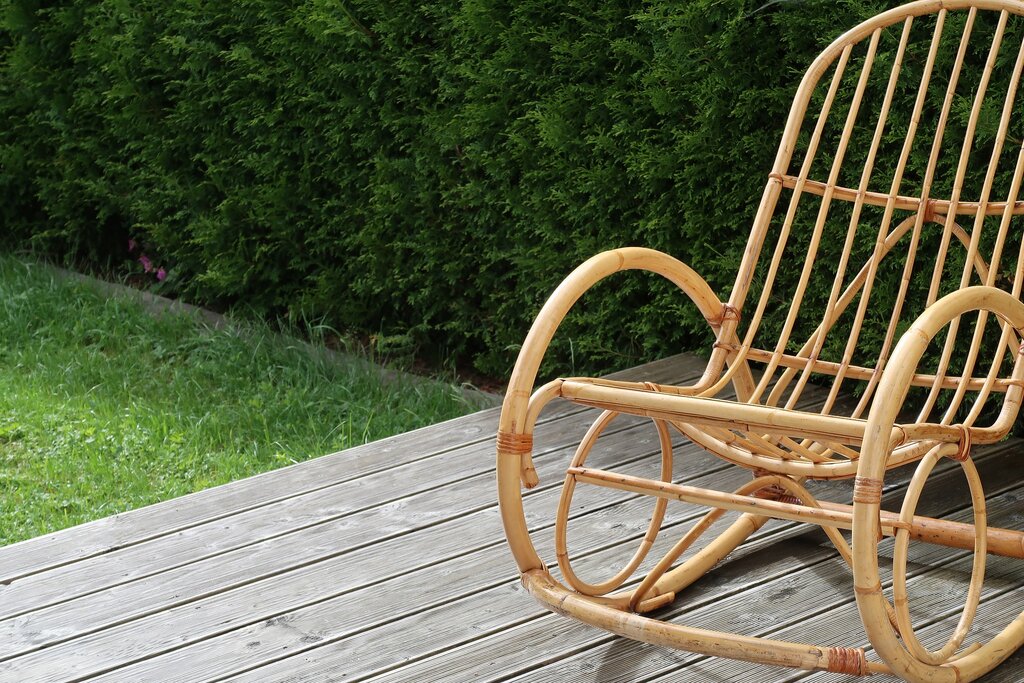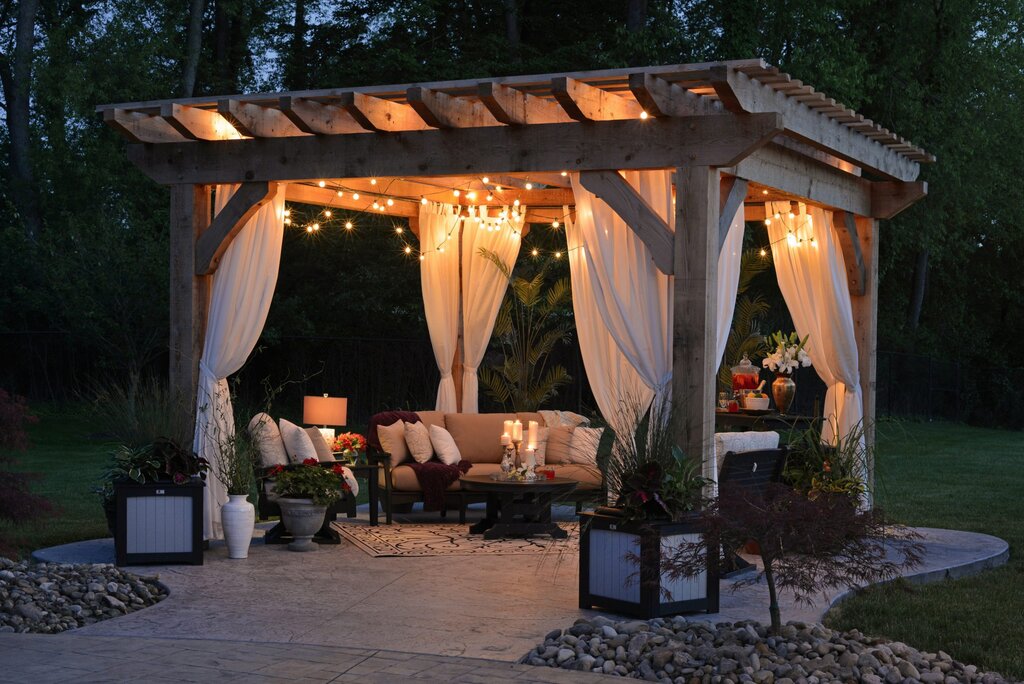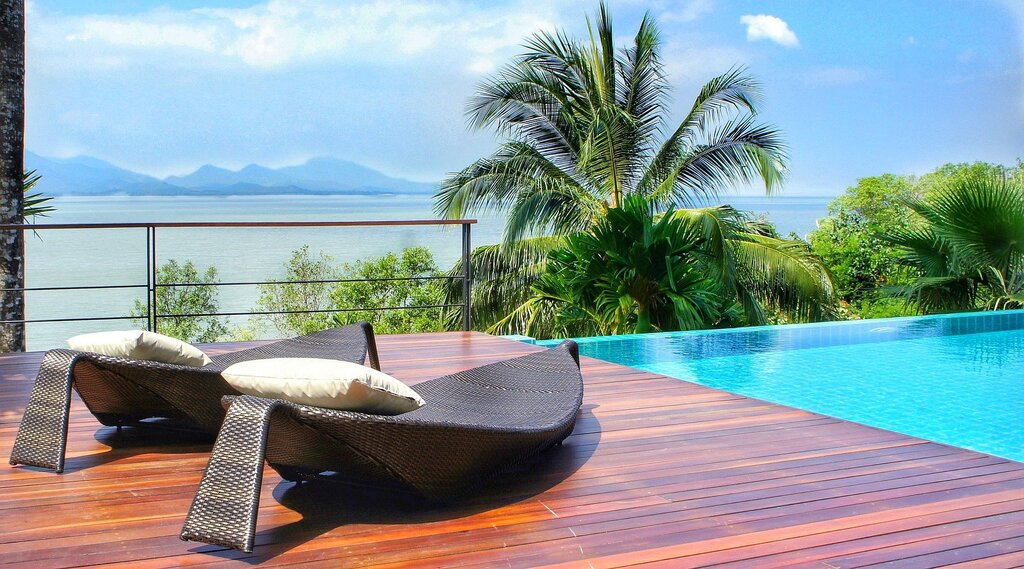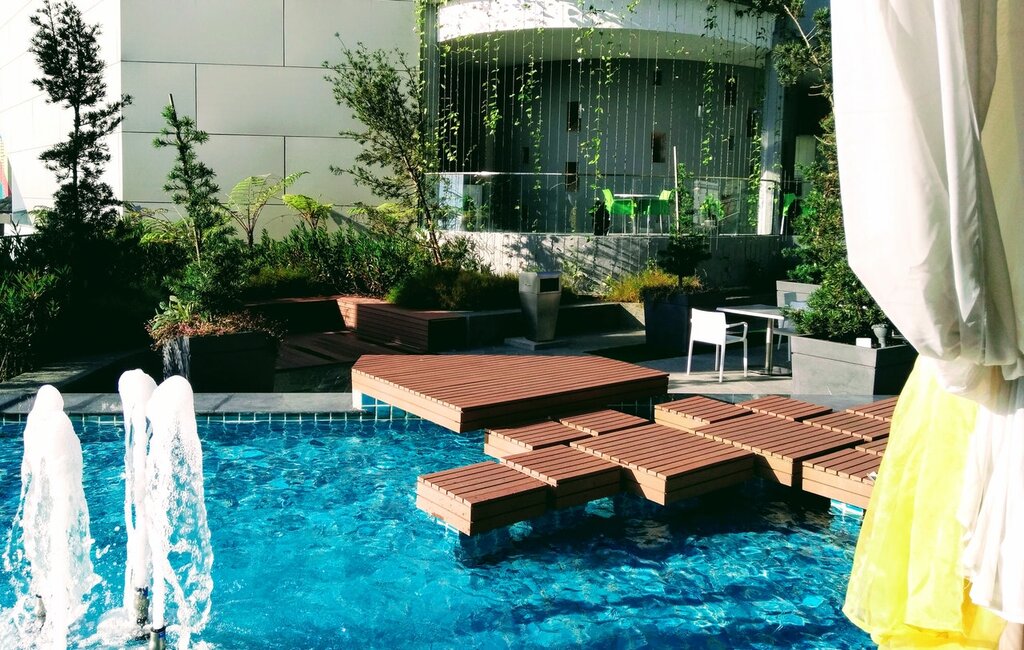
They say, “If you have a garden and a library, you have everything you need”. Well, maybe not everything you need, but in the last two years, when we were confined to our homes because of the Coronavirus pandemic, a garden would have been a true blessing. The truth is, with the best garden decking ideas and some DIY magic, you can turn your garden into a little relaxing paradise.
There are obviously different types of garden decking, and garden decor ideas that you can try for your outdoor space, and not all of them need to be expensive. So, don’t worry about that! You can create a holiday-at-home kind of decor with a little bit of imagination and the right outdoor deck tiles.
So, take a pen, some paper, and a tape measure and let’s start planning your garden composite decking. First, you need to decide the purpose of your garden decking. Will it be just for some chill time, or are you going for more heavy use where you’ll host several parties or even work sessions? Depending on this, you choose the decking materials and style.
Secondly, it’s better to determine from the start whether the decking should be attached to the house or free-standing. This will depend on the size of your garden, the space you’ve got at your disposal and, finally, your own preferences. Nevertheless, if you’re an absolute outdoor party lover and your living room or kitchen give on to your garden, it would be perfect for enabling access to the deck from home. Then, you will be able to go in and out without having to walk around, for instance, to bring something.
Why You Need These Garden Decking Ideas
The idea of outdoor decking is to create a clean space where you can rest, soak up the sun, and enjoy the fresh air. Moreover, these decking ideas will also add value to your property. Garden decking is a smart investment; make no mistake about it.
A deck is usually durable and very useful both in summer and winter. A good quality outdoor decking will increase your living space and enable you to make the most out of every inch of your garden. What is more, it will make garden parties so much easier. Besides, it is really low-maintenance, and it will last for years.
Before installing garden decking, you should consider where the sun sets and where it rises to ensure you’re making the most of your garden space. Installing a roof over your decking is not a bad idea either.
What is more, decking helps with the zoning of your garden, i.e. creating individual areas in your yard, especially if you’ve got plenty of space for it. I mean, during the pandemic, our gardens have turned into gyms, pubs, offices and even holiday destinations. Decking helps keep these “areas” separate.

Last but not least, decking really does work for any garden, and you should at least follow this decking guide for more on that.
Decking Ideas for Small Gardens
Small garden decking is a great idea to liven up tiny outdoor spaces. Whether you want to chill or enjoy al-fresco dining, these small garden decking ideas are aesthetically pleasing while also feeling homely.
So, imaginative patterns, different wood tones, or eco-friendly plastic/wood blends are all popular decking designs for small gardens.
Moreover, among the most popular small garden ideas in the UK, you’ll also find slip-resistant finishes that allow for all-weather use. If you want, read more about the different types of wood finishes.
And now, let’s make a list of 10 decking ideas for small gardens, shall we?
1. Install a Pergola to cover the small garden decking
A pergola will provide cover for a perfect al-fresco dining experience, even if it’s raining. In fact, that is the beauty of it. Imagine having dinner on a superb chill summer night with a little bit of rain. The sound of raindrops will feel really particularly relaxing.

Moreover, you can add climbing plants like magnolia or honeysuckle to cover the uprights. It will give the whole ensemble a more natural feel. Yes, it will look stunning, and just imagine the heady, natural fragrance of these plants! Simply lovely!
2. Treat your garden decking with an anti-slip solution
If you went with small garden decking ideas on a budget, it would be a good idea to add an anti-slip solution to it. Wet, slippery garden tiles can be dangerous, especially for the little ones running around.
3. Boardwalk Pathways
If you want to keep a small part of your garden wild, or if you cannot attach the decking directly to your house, you should consider boardwalk pathways. They are solid, low-maintenance and easy to install. Moreover, they will provide you with perfect garden zoning.
4. Build a Bar
If entertainment is top of your list, then you need to install a bar, however small, on your garden deck tiles. A tiki-style bar is great for summer parties and looks great. What is more, you can lay it on a raised platform for an extra effect.
However, don’t forget about the non-slip treatment. Apply it to the bar as well to avoid bar stool movement.
5. Dark wood stain is in vogue at the moment
These vibrant, dark deck nuances bring a more contemporary look to any small garden terrace. What is more, they create a great contrast with the lush green of the lawn or any colourful plants. So, yeah, dark decking is the way to go.
6. Use decking to box off sloping areas
Believe it or not, decking is also good for levelling out those uneven areas in your garden. It offers a certain structure to your outdoor area. So, don’t lose space on account of having hilly areas that go unused. You can make the most of your small garden with decking.
7. Get creative with colours
Small garden designs could benefit greatly from a splash of colour. Go for bright hues that complement each other, complement them with pastels for that contrasting vibe that will make summer outdoor nights so cool.
8. Combine decking with flagstones
For an ultra-modern look, you can combine stone paving with wooden decking. This contrasting combination creates an interesting finish. So, mix dark woods with light stones, maybe use some architectural beds to bring some greenery to your small UK garden.
9. Create seating from decking
So, seating manufactured from the decking is really cool and practical. It won’t take much space, and those sharp right angles are really great.
10. Use railings to section off your decking
So, if you’re looking for corner decking ideas for small gardens, railings are great. They section off a certain area of the garden and makes it all look cool.
Moreover, why not bring some of that interior cosiness to your outdoors? Try rattan sofas, comfy cushions and bright patterned patchwork. Of course, if you don’t have a pergola, you will need to store all these items inside during inclement weather.
Decking Ideas for Sloping Garden
Ok, so let’s stop here for a minute and discuss a few decking ideas for a sloping garden. You might believe that gardens on a hill are a true nuisance, but it’s not really like that. Yes, you need a little more planning and creativity, but there are plenty of landscaping ideas for a sloped garden. Let’s go for a quick list:
- Shelter a seating space with levelled borders and wooden-cladded flowerbeds
- Play with steps, pale walls, and raised seating areas
- Consider curved features that use the natural fall of the land
- Small terraces will make your sloping garden even more interesting
- Where the garden is too steep, try sloping flowerbeds with paved terraces and lawn
- So, what do you know about statement steps? Add them to your list
- What about a sunken seating area? Wouldn’t that be cool?
Overall, you should mix steps, sloping beds, gabions, borders, tiered planters with sweeping curves and railings. In fact, there are so many garden landscaping ideas for sloping gardens that when you get into it, you’ll absolutely love decorating.
Decking Patio Ideas
Well, when decking and patios are included in the same sentence, it is mostly about the differences between the two – the deck or patio question. It’s true, “patio” is a Spanish word, and it means “courtyard”. It is usually on the ground floor and made of concrete or gravel. Wood decking or raised patios are quite rare. Nevertheless, it doesn’t mean that you cannot have a patio deck. You can, and here are some deck and patio ideas to consider.

1. Concrete effect tiling
Concrete tiling is an increasingly popular material for home and garden design, from concrete worktops to tables.
If you’re looking for a simple but stylish patio floor solution, then concrete can be the way to go. Concrete is well-known for its hardwearing properties, and it will last you a lifetime.
2. Terracotta tiling
Tiles are the choice of many enthusiastic garden designers, and for good reason. Tiles can add a totally different dynamic to a patio area, particularly terracotta tiles. The design fits in nicely with other garden items such as terracotta pots and does offer a classical, if not Mediterranian, feel to your outdoors.
If you consider tiles for your patio area, it’s a good idea to buy more than you need. As tiles can crack or become damaged over time, having a few spare in case this happens is a good idea.
3. Ceramic tiling
Ceramic tiles are not just for bathrooms or kitchens. They could give gardens a clean and polished look as well. What is more, ceramic tiles are very easy to clean. Just give them a nice hosing down from time to time.
Besides, you can play with these tiles, randomly placing them on garden walls or plant pots, to make the whole space look more lively. Nevertheless, if you do choose to use ceramic tiles for your patio floor, be aware that they can become slippery when wet.
4. Mosaic patio flooring
Mosaic can be a good idea for large patio areas. So, you can get very creative with the patterns, designs and materials you want to use to create the mosaic floor. You could use stones, tiles or bricks. However, if you plan on doing it yourself, do note that it might take some time. It is very meticulous work.
5. Garden Decking
A large patio allows for multiple styles and designs. So, you can integrate decking into it very easily. Patio decking has advanced a lot in the last decade, allowing for more flexibility than before. There are now a wide variety of decking options available to make your patio stand out.
6. Composite Decking
So, composite decking usually requires less upkeep than wooden decking. It is available in a range of styles and finishes, as well.
Composite produces a lower carbon footprint than wooden decking and also doesn’t warp so much over time. It is very easy to clean, and it doesn’t require varnishing, painting or any other type of “special treatment”. Moreover, it is not as slippery as tiles.
Composite decking is very simple to install. You could do it yourself. Last but not least, you should know that, unlike wooden decking, composite decking is more hardwearing and isn’t prone to splits or knots. It’s also very affordable and long-lasting.
Pool Deck Design Ideas
Who doesn’t love summertime by the pool, soaking up the sun in between swimming sessions? Sounds like fun and vitamin D? Yes, it does.

However, if you’re willing to make a big splash this summer, you might want to make sure your pool deck is on point. Here’s a quick list:
- Limit the decking to the limits of the pool, and expand all the other green areas around; some palm trees would also be great
- Build a transparent pen on one margin of your pool, to make the most of the sleek, minimalist design
- Embrace a wide variety of materials and accessories
- Experiment with fun wood stains, quirky umbrellas, or lively side tables
- Maybe match the decking with the roof of the house
- Line the pool with some funny tiles that will complement the decking
- Nevertheless, you should always keep durability in mind

Best Wood Choices for Decking
Wood has long been the most popular choice for decking – and for a good reason. Wood deck boards offer a natural, strong feel and are easy to install. They also feel good under bare feet, and it doesn’t usually get as slippery as stone tiles. But now, there are all types of wood deck options to choose from. So, what would it be? Softwood or hardwood?
Wood decking
Softwood for decking includes pressure-treated Southern Yellow Pine, Scots Pine, European Redwood or Cedar. They are durable and budget-friendly.
Hardwood decking, on the other side, are even more sturdy but also heavy. It will resist many more years to water and algae, and it isn’t particularly slippery either. If you choose hardwood decking, pick a more vibrant colour. You will have the hardwood decking for some time, and rich, vivid colours usually keep their “new” shine for longer.
The wood decking colour will change over time. There’s not much you can do about it. You could, however, oil, stain and recoat your wood deck to keep it lively, but you need to do this periodically.
Timber Decking
Timber is a natural material, so it will change when exposed to certain weather elements, from rain to the scorching summer sun. Moisture can trigger some movement in the timber boards, and the sun can degrade the colour. Fortunately or unfortunately, this is a normal process, and it won’t affect the integrity of your timber decking.
When choosing your decking timber, consider matching the decking colour and style with your internal floorboards to integrate the inside and outside, creating a visually more extensive area.
Composite Decking
Composite decking is the result of binding together wood fibres and plastic with the use of a binding agent. This manufacturing process guarantees its durability.
The most important advantage of composite decking is its relatively low maintenance. If you don’t have too much time to spend with wood treatments, then go for a composite decking solution. All you need to do is sweep it and hose it down once in a while.
Composite decking is not dull at all; make no mistake about that. You have a wide variety of composite boards to choose from. They can be stained or painted in various shades and wood patterns.
In fact, you can choose any colour you want for your composite decking. If you feel like going with something crazy, unusual, wow, then do just that.
Moreover, composite decking is quite a high-friction surface, so don’t worry about slips. Nevertheless, there are also some downsides to composite decks:
- In time, it might not look like wood anymore (and that’s because it is not wood)
- It is not an entirely natural solution, but it is recyclable
How to Build Decking
If you want to know how to build a deck as a DIY project, well, it’s a pretty straightforward process. If you’re thinking about building a raised deck or building a deck on a slope, well, that might be a bit more challenging. But we’re only going to look at how to build decking laid on flat, level ground. So, let’s get going.

We recommend you also enlist a friend to help you, especially if it’s the first time you build a deck. Wear protective gear. Remember, your safety is the most important. Moreover, make sure there are no cables or pipes underneath the surface where you’re going to lay your deck. If there are, you also need to build a trap door in your decking for access. So, plan that in advance. One last thing for your safety – do not burn any of the remaining timber. The smoke and ash might be toxic from the wood treatments.
Your protective kit should include:
- protective and rigger gloves
- gloves
- safety glasses
- dust mask
- ear plugs
- knee pads
For building the deck, you will need:
- tape measure
- pencil
- club hammer
- edger
- spade
- spirit level
- weed control fabric
- gravel
You will also need a jigsaw, screws and bolts, a combi drill, maybe even a panel saw. A workbench would also be nice. Decking and grain protector is also necessary, and don’t forget the paintbrush for applying it.
How to Build a Decking Frame
The key to a sturdy and long-lasting deck is the decking frame. So, first, you prepare the site – clear away any weeds and make sure you get rid of all the rocks.
Secondly, you need to decide on the substrate. Is it going to be concrete, or will you lay the deck straight onto the ground? The first option offers more stability, but it is more time-consuming. The second one is easier, but the ground needs to be perfectly even and strong. If you choose to install the decking on the ground, you need to lay a specific fabric underneath it that will keep weeds from infiltrating into your decking.
Now, about cutting the deck boards – if you have a lot of deck boards to cut, use a mitre saw. If it is a simple project, then a panel saw will do the job. What is more, you will also need a jigsaw for all those little cuts and shapes.
Once the oversite is prepared, it is time to lay the decking frame. First, draw a line alongside your perimeter. Start on the outside, and fix the joists together along the whole perimeter. Bolt or drill the joists together. Only use galvanised screws. To keep your outer frame secure, the best practice guides recommend:
- 1 screw on the top edge of the joist
- 2 screws on the sides
Last but not least, remember to put wood preservatives on the sawn wood and the screws.
How to Lay Decking
If you want to attach the decking to your house, you need to do it now, after you have built the decking frame. Anchor it firmly to the adjoining wall, and you’re ready for the next stage.
The long bits of timber that sit between the outer frame are called joists. They support your deck boards, and you need to fix them firmly into place.
If you’re placing the boards horizontally, then the centre spacing between the joints should be 400m. If you’re laying the boards diagonally, then keep it at about 300mm or less. Three joists are enough for a small, basic deck. Larger structures require more complex joist configurations.
Now you’re ready to lay the boards of your deck. It is almost like laying laminate flooring.
Start on one edge of your frame. If you’ve attached the decking to the house, start there, closest to the building. Remember to leave a small expansion gap of 3-5 mm between the boards. That’s about the width of a fixing screw.
Get all the boards on the frame before you start fixing them. Make sure that they’re positioned accordingly and that the deck frame is covered. If you’re happy with how they look, start fixing them.
Fix each board on all four corners. Pre-dill the holes rather than hammering the nails down to avoid cracks or splits. Little by little, your wood decking is shaping up nicely, isn’t it?
We hope our guide was useful, and that it helped you in choosing and installing the perfect garden decking. Until next time, don’t forget that your home is your castle. Treat it that way!
| Mon-Fri | 8:00AM – 5:00PM |
| Saturday | 10:00AM – 4:00PM |
| Sunday | 11:00AM – 3:00PM |





.svg)
.svg)